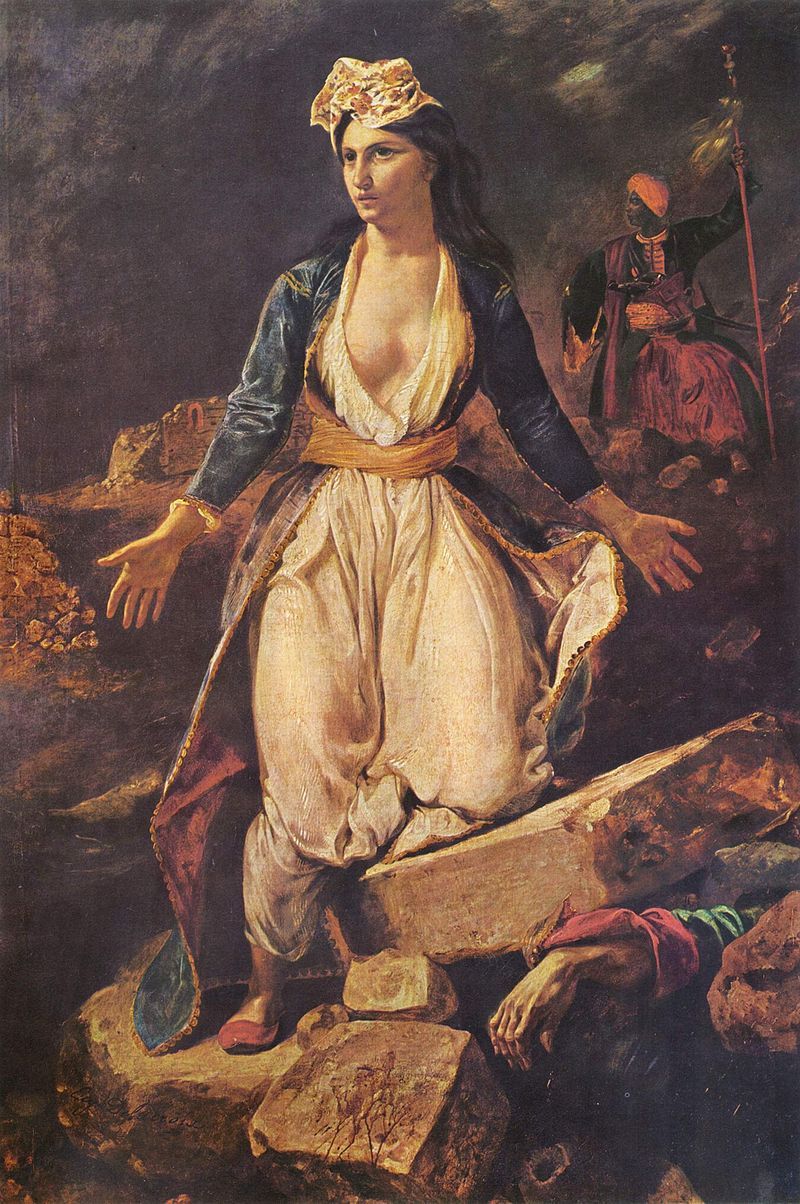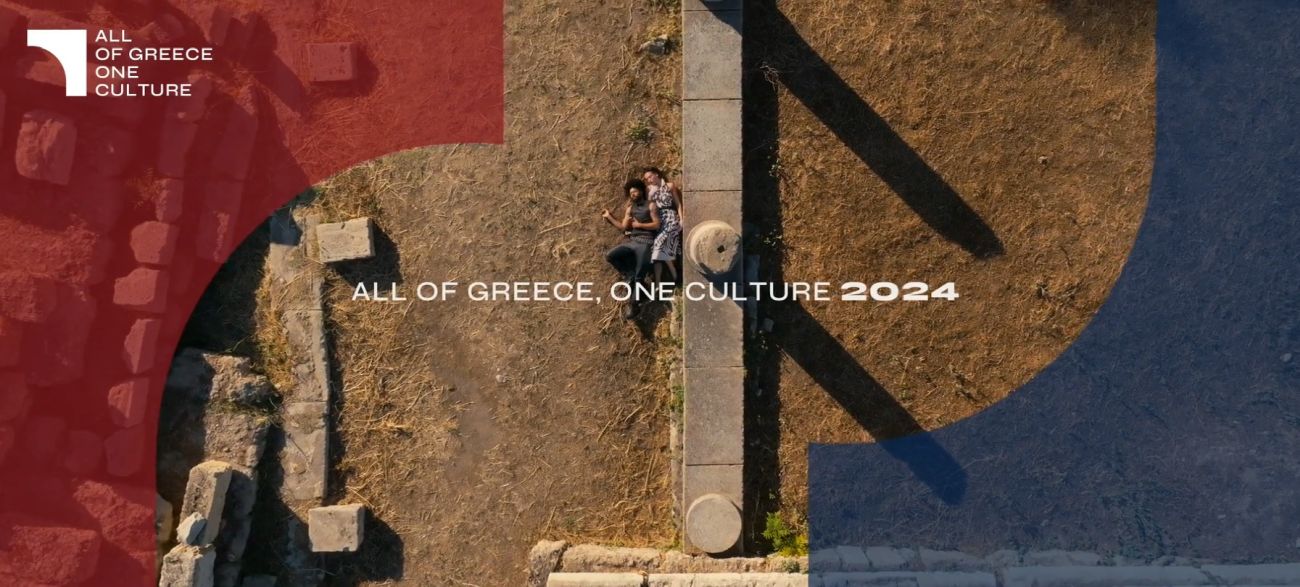The Greek Revolution plays a key role in the history of Greece. The Greek War of Independence, also known as the Greek Revolution (in Greek: Ελληνική Επανάσταση, Elliniki Epanastasi) was a successful war of independence waged by Greek revolutionaries against the Ottoman Empire between 1821 and 1830. This year, 2021, marks the anniversary of 200 years of the historical turning point.
The Greek Revolution Celebrations
To honor this special year, the Greece 2021 Committee has been appointed to design a program of projects and events which will aim at reintroducing Greece, from the beginning of its contemporary history to today, in the course of 200 years. Read on about The Greek Revolution celebrations.
Greek Revolution of 1821
The Greek Revolution plays a key role in the history of Greece. Greece had been part of the Ottoman Empire since 1453. The Greek revolt was precipitated on March 25, 1821, when Bishop Germanos of Patras raised the flag of revolution over the Monastery of Agia Lavra in the Peloponnese. The cry “Freedom or death” became the motto of the revolution. The Greeks experienced early successes on the battlefield, including the capture of Athens in June 1822, but infighting ensued. By 1827 Athens and most of the Greek isles had been recaptured by the Turks.
Just as the revolution appeared to be on the verge of failure, Great Britain, France, and Russia intervened in the conflict. The Greek struggle had elicited strong sympathy in Europe, and many leading intellectuals had promoted the Greek cause, including the English poet Lord Byron. At the naval Battle of Navarino, the combined British, French, and Russian forces destroyed an Ottoman-Egyptian fleet. The revolution ended in 1829 when the Treaty of Edirne established an independent Greek state.
The Greek Revolution is a crucial part of Modern Greek History and the rest of the world. Not many realize that the outcome of the Greek Revolution was the pivotal point on which the whole geopolitical map of Europe tilted away from the eighteenth-century model of multi-ethnic, autocratically ruled empires and towards the twentieth-century model of the self-determination of nation-states. The Greek Revolution is celebrated by Greeks around the world as Independence Day on 25 March.
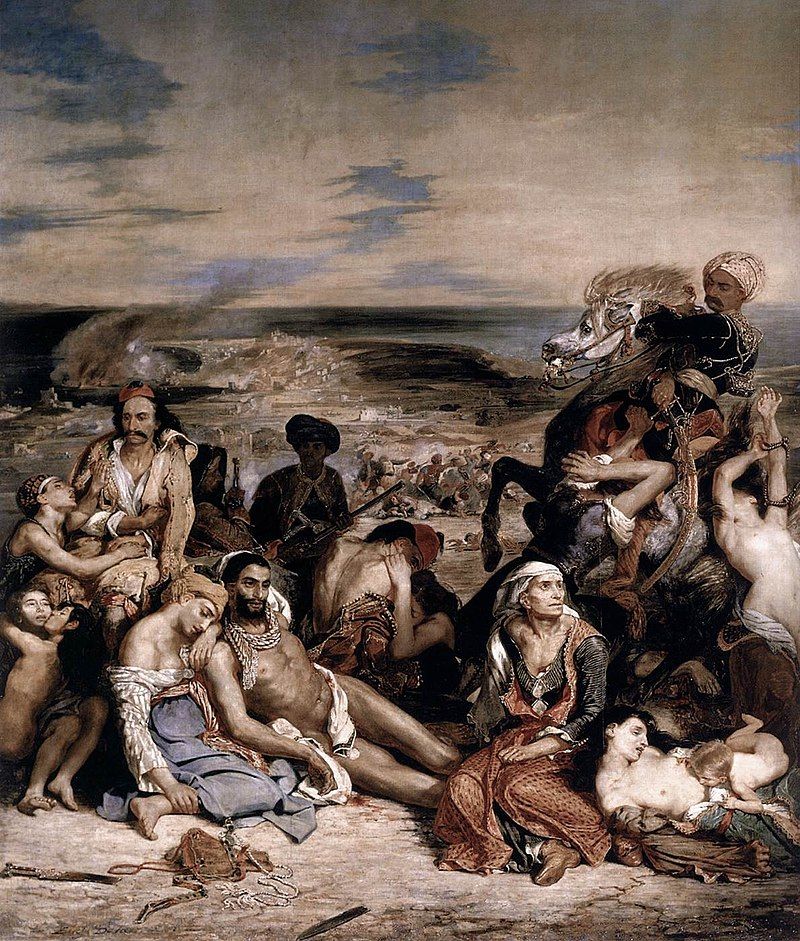
The Holiday of 25 March
Each year, on 25 March, Greece celebrates the national holiday called Independence Day. This day commemorates the start of the Independence War in 1821.
In celebration of Greek Independence Day, towns and villages throughout Greece hold a school flag parade, during which schoolchildren march in traditional Greek costume and carry Greek flags. In Athens, the festivities start one day prior on the 24th March with an annual student parade. School students and other youth associations march through central Athens past the Hellenic Parliament in Syntagma, dressed in school uniform and traditional Greek clothes.
On the 25th of March, a grand military parade takes place mid-morning in the central streets of Athens. The parade includes planes from the Greek air force, civil and military marching bands followed by a procession of military vehicles. The parades are attended by the president of Greece and other dignitaries and usually bring out lots of Athenians waving flags and celebrating.
A Greek celebration cannot be complete without a national dish. The traditional food on Greek Independence Day and Annunciation Day is ‘Bakaliaros Skordalia’, a delicious batter-fried cod served with a mashed potato garlic dip made with olive oil.
Read also: The 25 March Holiday in Greece.
Historic places related to the Greek Revolution
Greece is filled with monuments and historic places related to the Greek War of Independence. We’ve been travelling to many of these over the past years. During most of these trips, my children came with me and the history lessons learned are definitely invaluable! We have seen Delacroix’ paintings in the museum of Messolongi, visited the grave of Lord Byron and read one of the first copies of the Greek national anthem.
Greek history is very much alive and children will be able to understand more of this difficult part of the past by looking at objects and art. I have listed the travel articles of the most important places related to the Greek Revolution in the links below.
Travel to monuments from the Greek Revolution with Kids
- Nafpaktos with Kids (including Messolongi)
- Travel Epirus with Kids (including Ioannina)
- Gialova Messinia Greece Holiday (Battle of Navarino)
- Arkadi in Crete. Symbol of Freedom
- Meteora with Kids
- Nafplion with Kids
Watch the Evzones

The Evzones are originally a historical elite light infantry and mountain units of the Greek Army, but their name nowadays refers to the members of the Presidential Guard, a ceremonial unit that guards the Greek Tomb of the Unknown Soldier. The uniform of the Presidential Guard refers to the uniform of Greek warriors during the War of Independence in 1821. The white skirt of the uniform has 400 folds to represent the 400 years of Ottoman occupation over the Greeks. Each side of the white shirt sleeve also has 200 folds. We had the chance to visit the Evzones Army Camp and their workshop of their tailors. You can read more about this experience in Athens with kids, Where to see the national guards?
Greek Revolution in the Arts
An art-loving family, I wanted to mention the arts too. The Greek Revolution has inspired artists in many countries. Philhellenism, the moral yet above all practical support to the Greek nation, then fighting for independence, which manifested itself in many European countries, found its ideal expression in France. It should be noted that the Enlightenment and the French Revolution appealed to many and drew them to the fighting Greece. Side by side with political and social philhellenism, the Greek ordeals inspired intellectuals, poets and painters. The massacre at Chios, in April 1822, inspired the young romantic artist Eugène Delacroix to create the eponymous monumental painting in the Louvre. Delacroix’s Greece in the ruins of Missolonghi, the depiction of a nation’s holy passion, came in response to another historic event in the War of Independence: the heroic Exodus from Missolonghi, in April 1826.
About the featured photo Greece on the Ruins of Missolonghi is an 1826 oil painting by Delacroix, and now preserved at the Musée des Beaux-Arts de Bordeaux. This painting was inspired by the Third Siege of Missolonghi by the Ottoman forces in 1826, during which many people of the city after the long-time siege (almost a year) decided to attempt a mass breakout to escape famine and epidemics. The attempt resulted in a disaster, with the larger part of the Greeks slain. The image portrays a tragic episode from 1825 when the Greeks preferred to destroy their city and commit suicide rather than to surrender. Greece is shown symbolically as a woman, dressed in traditional costume, with the tragedy enfolding at her feet. The figure recalls the Virgin Mary standing over Jesus’ body. The event was of personal importance for Delacroix as Byron, whose work he admired greatly and who provided inspiration for his own work, died nearby.
Books about the Greek Revolution
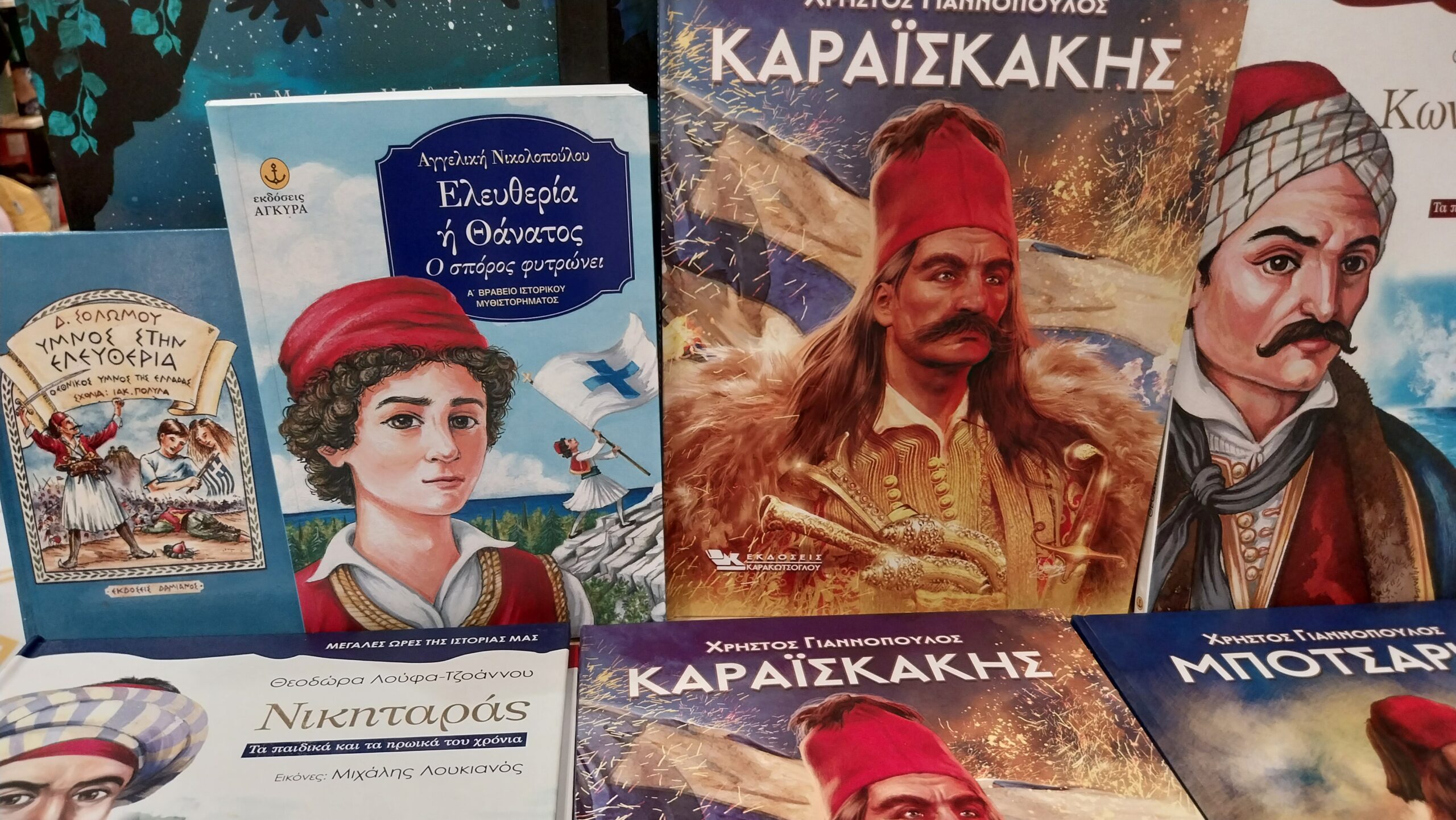
ELTA: Children’s Painting Competition for the Revolution of 1821 – “Your painting will become a stamp!”
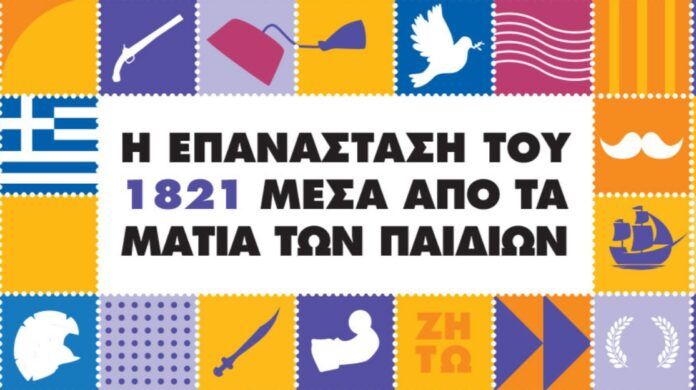
Hellenic Post invites children aged 7 to 15 to an original, online children’s painting competition entitled “The Revolution of 1821”, from which the stamps of the next series of stamps will emerge.
At 1821.elta.gr, children can download the standard outline of the stamp, paint freely inside, inspired by the Revolution of 1821, and then photograph and upload their painting on the platform to participate in the competition and the “digital” exhibition.
All participants will receive a personal stamp sheet with their work as a souvenir. The first twelve, will also win another special gift from the Art Post Collection.
However, the four paintings that will be distinguished (two by children aged 7-10 and two by children aged 11-15) will receive the grand prize: their artwork will become a postage stamp and will travel mail around the world!
Specifically, these works will be the Commemorative Stamp Series “CHILD AND STAMP – THE GREEK REVOLUTION THROUGH THE CHILDREN’S EYES” which will be released on October 7, 2021 and will be available throughout the ELTA network. The competition ends on Sunday, May 9, 2021. More information at https://1821.elta.gr/
Museum of Cycladic Art Kids Contest
‘Through our new digital platform, we discover ways to create, find information and gain knowledge that introduces us to the universe of History and Art.’
On the occasion of the exhibition “Antiquarianism and Philhellenism. The Thanassis and Marina Martinos Collection” at the Museum of Cycladic Art, children, ages 4 to 15, are invited to bring their own “Everyday Heroes” to life. ‘Through paintings, sculptures and other artworks, we search for information and learn about the Heroes of that period, and connect them to their contemporary counterparts. Who are your own Everyday Heroes, and what makes them stand out?
We see them all around us, we imagine and draw them, making them even more unique!’
The Greek Revolution with PLAYMOBIL
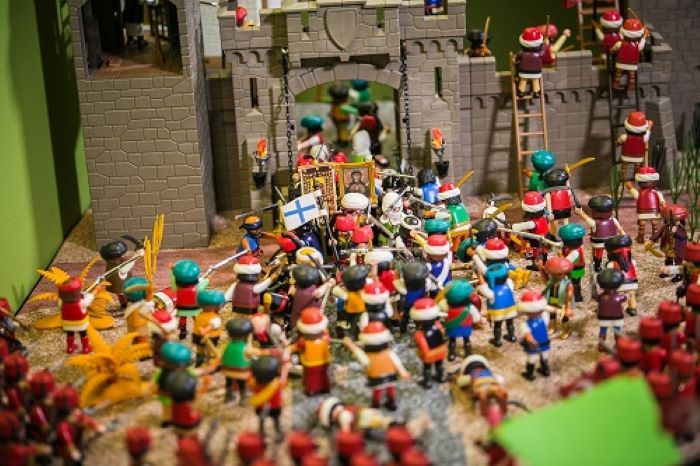
The Cultural Foundation of the Piraeus Group (PIOP), together with the National Historical Museum (EIM) presents the exhibition “In ’21 otherwise: The Greek Revolution with figures and dioramas PLAYMOBIL “. With PLAYMOBIL dioramas and figures, this exhibition is an original approach to what took place is attempted, from pre-revolutionary times to the founding of the modern Greek state. Small colorful figures “compose” battlefields, represent historical events, describe everyday scenes, depict significant figures of the Struggle.
The Oath of Friends, the Fall of Tripoli, the Exodus of Messolonghi, the Flight of Parginas, are some of the dioramas that dominate the exhibition that is especially nice for young kids. Protagonists of the Revolution, Greeks, Philhellenes and Ottomans, men and women who played an important role in the course of events, are presented in PLAYMOBIL figures, accompanied by a short biography. The exhibition will be on display in 3 different locations in Greece but can also be seen online.
Museum of Olive and Greek Oil in Sparta (6/10/20 - 31/5/21), Museum of Industrial Olive Oil of Lesvos (16/6/21 - 17/10/21) or the Museum of Brick and Tile in Volos (1/11/21 - 30/1/22) or virtual via this link.
Stavros Niarchos Foundation
In celebration of the 200th anniversary of the Greek Revolution of 1821, the Stavros Niarchos Foundation Cultural Center (SNFCC) is presenting a series of events, titled Faces of the Hero, which was created and is implemented through an exclusive grant from the Stavros Niarchos Foundation (SNF).
The heroic example set by the fighters of the Greek Revolution provides the impetus for an examination of the concepts of “hero” and “heroism” throughout time, through the prism of the performing and visual arts, dance, readings, lectures, exhibitions, and educational programs for adults and children. The connecting link permeating all the programs is the question, “How has the heroic ideal been reflected through art?”
The selection of the multifaceted thematic programming is a reflection of the mission that drives the SNFCC overall: to be an open public space that offers cultural experiences, entertainment, and education for all. The anniversary programming is centered around activating the SNFCC’s premises and developing synergies with its affiliate organizations, the National Library of Greece (NLG) and the Greek National Opera (GNO), while also focusing on investing in the organization’s artistic outreach.
Find out more about the events included in the SNFCC’s anniversary programming here.
Benaki Museum Virtual Greece 2021 Exhibition
The Benaki Museum has designed a free virtual exhibition to mark the bicentenary of the Greek Revolution, ahead of its physical opening to the public, when lockdown lifts. With 1,200 exhibits spread across the 2,500 square metres of the Benaki’s Pireos Street Annex, “1821 Before and After” offers one of the most comprehensive panoramas of a pivotal century in the history of Greece (1770-1870). Watch this colourful 22-minute gallery video tour to check out the exhibition high points and hear interviews with the key players who helped bring it to light (with English subtitles!). The exhibition takes place from 3 March until 7 November 2021.
Other Museums Celebrating 2021
The Museum of Byzantine Culture in Thessaloniki participates in the National Act “21”, to celebrate the 200th anniversary of the revolution of 1821. We inform you that when we begin to accept visitors the entrance will be free for the public on the 21st of each month.
The (recently renovated) National Gallery was founded in 1900 and today includes the collections of more than 20,000 paintings, sculptures, engravings and other art forms and is the treasury of Modern Greek artistic creation, covering a period from the post-Byzantine period until today including paintings presenting scenes from the 1821 Greek War of Independence. Greek PM Mitsotakis will host a tour of the Gallery with his official guests who will visit Athens on March 24-25 for the 200-year anniversary from the Greek Revolution. The official inauguration of the National Gallery will be held in June 2021, if the pandemic allows it.
Women in the Greek Revolution of 1821 are represented by the collection of Michalis and Dimitra Varkarakis at the B&M Theocharakis Foundation for the Fine Arts and Music. The spirit of philhellenism and the insuperable heroic stature of the Greek Woman during the years of the Greek Revolution of 1821 emerges most emphatically through the masterpieces of the superb Collection of Michalis and Dimitra Varkarakis. These are works that teach us our history, the pain and heroism of women, either as mothers or as symbols of sacrifice. Therefore, the primary role of women in 1821 is revealed by the exquisite paintings, from the Greek Mother With Her Dead Child and the Abduction of A Greek Woman, from the first half of the 19th century by Louise Vallot, to the Greek Women Praying to Madonna For Protection During a Battle by Ary Scheffer and the painting Women From Souli in Battle ascribed to Konstantinos Iatras.
Meet the heroes of the Greek Revolution for children in English
Do your kids think history is boring? So how would they feel if they learned about a historic event through Playmobil figures and accessories? Or if you discovered a historical figure through drawing?
On the occasion of the “’21 otherwise” exhibition of the National History Museum, Playmobil introduces some of the protagonists of the time. Because History is not only the dates and events – it is, mainly, the people and the small and big moments of their lives…
Credits: Study Rooms
Video for 200 Years of Greek Independence
The “Greece 2021” committee released a video to celebrate the 200th anniversary of the Greek War of Independence. The soundtrack for the video is the song “May the dances never stop” (As kratisoun oi horoi) by singer-songwriter Dionysis Savvopoulos. President of the “Greece 2021” Commitee Gianna Angelopoulos-Daskalaki explains the choice for this song as follows: “We chose this song because it describes our common journey uniquely. In these 200 years, our ‘assembly’ unfolded and evolved. Our ‘bond became denser.’ We fell many times, but we rose again and ‘our friendships continued to write history’. In 2021 we will look ahead. We will merge our ‘longstanding and flaming orbits’ with a bright and hopeful future. Because the journey of the Greeks continues. So, may the dances never stop!”
The four pillars of Greece 2021
The celebrations and events will be based on the following four pillars set by the Committee “Greece 2021”:
“The Greek Revolution of 1821 as a pivotal chapter in Greek history and a piece in the puzzle of world history“
The goal of this pillar is to comprehend the Greek Revolution of 1821, to highlight its significance, its relationship with other revolutions and wars for independence that flared up at approximately the same time, and the effect it had on the rest of the world and how it was affected by it.
“Greece today, 200 years after independence”
The goal of this pillar is to highlight the dynamic components of contemporary Greek society through the creativity and participation of foundations, universities, local authorities, research institutes, cultural institutes, as well as individuals, etc.
“Greeks who left their mark on the world in the last 200 years”
The goal of this pillar is to feature the lives and work of Greeks who left their mark on Greece and the world, in science and arts, won Nobel prizes and Academy Awards, saved thousands of lives with their scientific discoveries and won world recognition and respect.
“2021 as a window of opportunity for the future of Greece”
This pillar refers to the driving forces that can contribute to Greece’s development in the future emphasizing on the country’s response to big challenges such as climate change, sustainable growth, peace and international collaboration, 4th Industrial Revolution etc.
The emblematic actions
In this framework, four emblematic actions will be implemented by the Committee and more precisely:
- The organization of an international Forum under the theme “Greece in 2040” where Greek scientists, world-renowned personalities but also the Greek society will map the country’s path to the future.
- The creation of a Research Institute for Artificial Intelligence, an initiative that will put Greece at the forefront of the global technological avant-garde.
- The “Festival of the Cities”, an action with simultaneous celebrations next summer in 51 cities in Greece, in the capital cities of the country’s prefectures.
- And the action “Walking in the Footsteps of 1821”, through which 200 young people will travel on historical routes associated with the Greek Revolution in 40 cities throughout Europe.
Greece 2021 Numismatic Programme
If you like coins or if you child is a collector, have a look at the numismatic programme of Greece 2021.
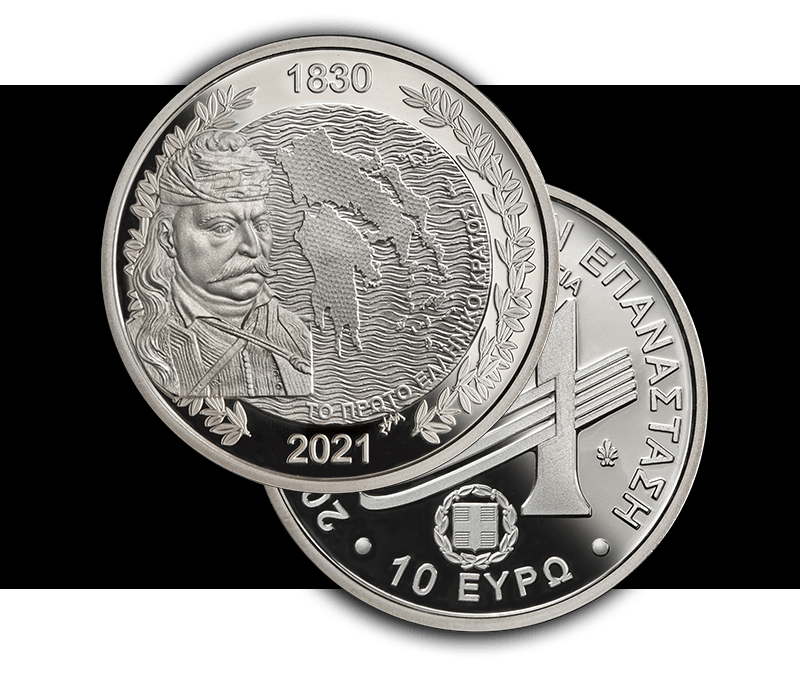
The Committee’s “Greece 2021” Numismatic Programme was implemented by the Ministry of Finance and the Bank of Greece. It includes the issuance of 14 coins of rare collectable value. On them, the internationally acclaimed engravers of the Hellenic Mint have engraved emblematic moments from the history of modern Greece. These 14 coins will be issued in limited numbers, while their molds will be destroyed after production, enhancing their unique collectable value.
What is included in the Committee’s “Greece 2021” Numismatic Programme
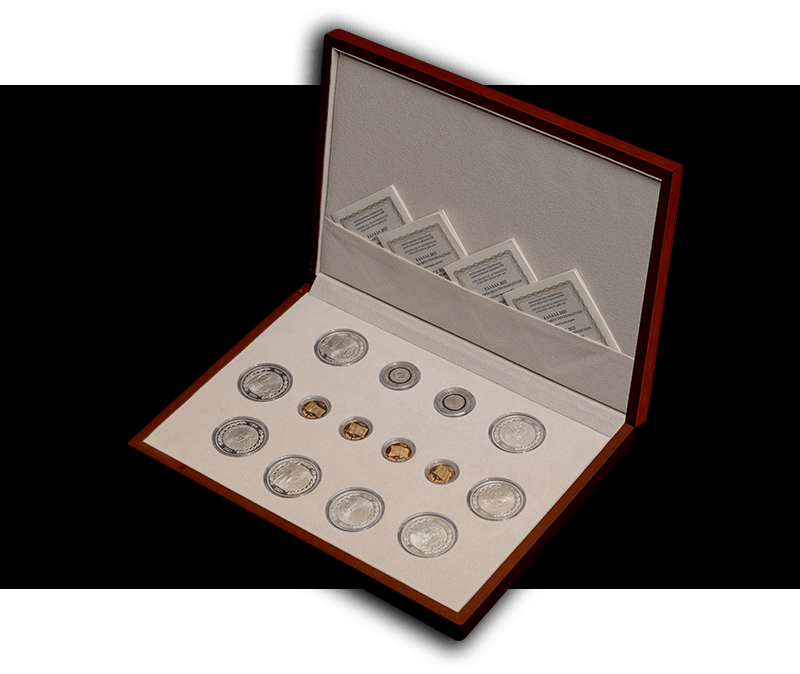
A unique three-part collection of 14 collectible coins: Two bi-metallic coins, which depict the first two coins of the Greek State: The Phoenix of 1828 and the first drachma of 1833.
Eight silver coins, with the expansions of the Greek territory: The first Greek State, with Theodoros Kolokotronis, The Ionian Islands, with Ioannis Kapodistrias, Thessaly and Arta, with Rigas Feraios-Velestinlis, Epirus, with Athanasios Tsakalov, Macedonia, with Pavlos Melas, Crete, with Eleftherios Venizelos, Thrace, with Georgios Vizyinos, The Dodecanese, with Lady of Ro.
And four gold coins with the historical evolution of the Greek flag: The flag of the Friendly Society, the Greek flag of 1821, The Greek flag of 1822 and the current Greek flag.
Photo credits Numismatic programme: Greece 2021
25 March 2021 Program
This year, there will be a military parade in Athens but the locally organized school parades are cancelled due to the pandemic. French President Emmanuel Macron, Russian President Vladimir Putin and Prince Charles are expected to be in Athens on March 25 to attend the celebrations.
For more detailed information on the events and celebrations as well as interesting stories about the Greek Revolution, you can also scroll over to the official website of greece2021.gr.
You may also like
The Greek Revolution Park, in Kato Ambelokipi, Messinia. The park opens in March 2023 and is designed to host 21 “Short Stories of Freedom” related to the 1821 Greek Revolution and connected to 21 historic Peloponnese municipalities, as well as 21 trees representing their flora.
The park is expected to become an important landmark honoring the Greek Revolution and its history. The park’s creative plan was an initiative supported by the “Greece 2021” Committee, and it is a candidate for inclusion in UNESCO’s National Index of Intangible Cultural Heritage.
Plans for the park include it becoming a host venue for cultural, environmental, and educational events, making it a significant hub for Greek culture and history.


